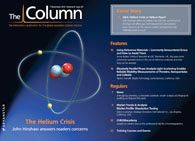Breath analysis
A group of scientists in Austria 1 have developed and characterised a method for the detection of S. pneumoniae and H. influenzae in the upper respiratory tract by analysing breath samples of patients.
Steptococcus pneumoniae and Haemophilus influenzae are the causative agents of community-associated pneumonia (CAP). CAP is principally responsible for the highest number of deaths resulting from bacterial infection. The illness mainly infects young adults, children and those who are immunocompromised because of a pre‑existing condition, such as patients prescribed with immunosuppressant drugs following organ transplantation. This group of patients are therefore unlikely to be comfortable undergoing current diagnostic tests that are considered invasive and slow to the point that the infection can become more advanced. This increases the demand for a non-invasive, rapid and economic test that can pinpoint the presence of infection before it can progress.
A group of scientists in Austria 1 have developed and characterised a method for the detection of S. pneumoniae and H. influenzae in the upper respiratory tract by analysing breath samples of patients. Using gas chromatography coupled to mass spectrometry (GC–MS), the investigators identified a broad spectrum of volatile organic compounds (VOCs) associated with the two infections. Headspace samples were adsorbed to multi‑bed sorption tubes prior to GC–MS analysis. The analysis resulted in the identification of 34 VOCs released from S. pneumoniae and 28 VOCs released from H. influenzae and interestingly for S. pneumoniae catabolism of aldehydes was detected.
These initial findings of differential chemical profiles associated with the two different respiratory infections indicate that there is the opportunity for the development of a portable breath gas analyser that may be less invasive and intrusive than current diagnostic methods. Further investigations are required to increase the sample number of patients and to eliminate patient variability.
1. A. Ammann et al, Microbiology, DOI: 10.1099/mic.0.0626870 (2012).
This story originally appeared in The Column. Click here to view that issue.

Regulatory Deadlines and Supply Chain Challenges Take Center Stage in Nitrosamine Discussion
April 10th 2025During an LCGC International peer exchange, Aloka Srinivasan, Mayank Bhanti, and Amber Burch discussed the regulatory deadlines and supply chain challenges that come with nitrosamine analysis.











